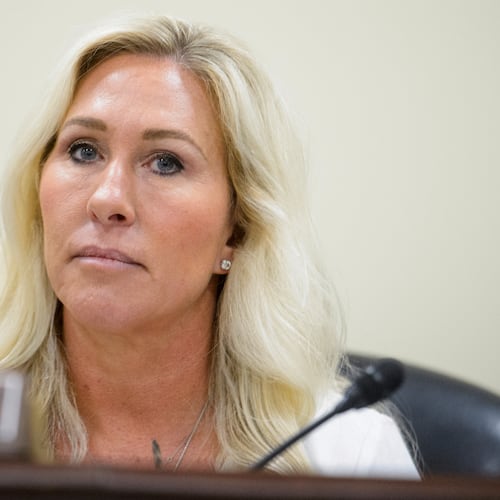Every installment in this endeavor to track how projection models were assessing the presidential campaign started with an editor’s note that contained this warning:
Polling results are often described as snapshots at a particular moment of time in a campaign. This, however, is more of a doodle, aggregating election projections from various sources, some that rely entirely on polling while others also take into consideration factors such as demographics and voting histories.
It turns out, however, that the polling results at the heart of those projections were not so much snapshots as Jackson Pollack splatter paintings. Maybe you had a chance to see that poll that showed Democrat Joe Biden up by 17 points in Wisconsin. Biden won there by less than 1 percentage point, and a recount is apparently coming.
Happily, there were exceptions, including The Atlanta Journal-Constitution’s final poll before the election. It showed Biden and President Donald Trump deadlocked in Georgia, and nothing says deadlocked like taking a week to count the votes.
There: Horn tooted. Let’s move on.
So how did that doodle do?
The picture is still a tad blurry, since the counting continues In a few states.
But, despite those instances of shaky data, the models got some things right.
Exhibit A: They all had Biden leading, with 14 of the 15 models we tracked giving him enough electoral votes to capture the presidency.
The models also did a decent job of identifying the battlegrounds. The last five states to be called in the race — Georgia, Arizona, Nevada, North Carolina and Pennsylvania — all were categorized as toss-up states on at least one model. Of course, some other states were frequently marked down as up for grabs where the races proved not to be all that close, including Iowa, Ohio and Texas.
But all the models also misfired.
If the candidates hold the states where they are leading, the final tally will be 306 electoral votes for Biden, 232 for Trump.
None of the projections were that precise.
Precision, however, wasn’t possible, with all but two of the models hedging their bets by leaving states in the toss-up category. Real Clear Politics, for example, left things real murky, classifying 12 states and two individual congressional districts as toss-ups — or nearly 37% of the entire Electoral College.
One of the two that made all the calls, not leaving states up for grabs, came pretty close, missing on only one state.
Sabato’s Crystal Ball projected a final tally of 321 for Biden to 217 for Trump. What tripped it up was predicting Biden would win North Carolina — obviously a narrow miss since the state still has not been declared although it appears headed for Trump.
North Carolina fooled many.
Only one model projected a Trump win there, the site PredictIt Market Probabilities, which, like Sabato’s Crystal Ball, shunned the classification of states as toss-ups. It’s also the model that treated the candidates as if they were commodities, setting prices on them. North Carolina apparently saw a bargain in Trump at 12 cents, compared with 89 cents for Biden.
What didn’t pay off for PredictIt was its projections that Trump would win Georgia and Arizona, two close calls
A prickly Peach State
Besides Sabato’s Crystal Ball, only one of the other models we tracked, Inside Elections Presidential Ratings, foresaw Georgia backing Biden. And PredictIt was the only other site to assign it to either candidate.
For the rest, the Peach State was too prickly a pick. They chose not to choose.
The other wild card
Florida was the other state that defied prediction by many. Four got it wrong, and Sabato’s Crystal Ball and PredictIt were the only two that got it right. The nine others said, “Pass.”
The report card
As it says above, the final tally will apparently be 306-232.
So how did each projection model do? Check it out for yourself:
270toWin consensus map (last updated two days before the election): Biden, 290; Trump, 163; Toss-up, 85
270toWin polling map (updated three times daily): Biden, 278; Trump, 125; Toss-up 135
270toWin polling with no toss-ups (updates three times daily): Biden, 351; Trump 187
CNN (last updated Oct. 7): Biden, 290; Trump, 163; Toss-up, 85
Cook Political Report (last updated Oct. 28): Biden, 290; Trump, 125; Toss-up, 123
The Economist (updated twice daily): Biden, 319; Trump, 182; Toss-up, 37
FiveThirtyEight (updated every two hours): Biden, 319; Trump, 125; Toss-up, 94
Inside Elections (last updated Oct. 28): Biden, 350; Trump, 125; Toss-up, 63
Niskanen Center (last updated Sept. 15): Biden, 318; Trump, 123; Toss-up, 97
NPR (last updated Oct. 30): Biden, 279; Trump, 125; Toss-up, 134
Politico (last updated Nov. 2): Biden, 279; Trump, 163; Toss-up, 96
PredictIt (updated every four hours): Biden, 290; Trump, 248
Princeton Election Consortium: Biden, 335; Trump, 187; Toss-up, 16
RealClearPolitics (last updated Oct. 29): Biden, 216; Trump, 125; Toss-up, 197
Sabato’s Crystal Ball (last updated Nov. 2): Biden, 321; Trump, 217; Toss-up, 0
U.S. News (last updated Oct. 28): Biden, 279; Trump, 163; Toss-up, 96
About the Author
Keep Reading
The Latest
Featured




